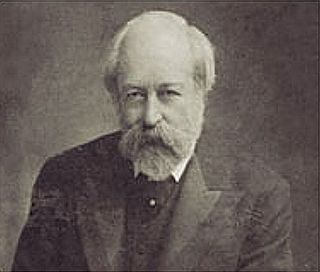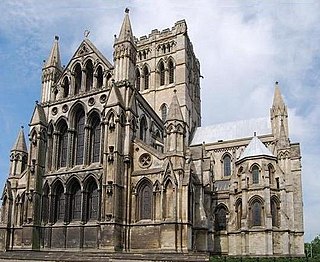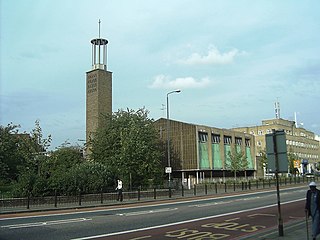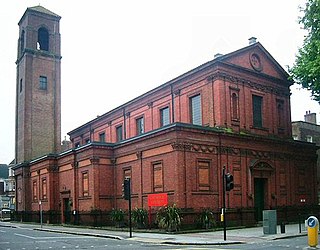
Poplar is a district in East London, England, now part of the London Borough of Tower Hamlets. Five miles (8 km) east of Charing Cross, it is part of the East End.

Sir George Gilbert Scott, largely known as Sir Gilbert Scott, was a prolific English Gothic Revival architect, chiefly associated with the design, building and renovation of churches and cathedrals, although he started his career as a leading designer of workhouses. Over 800 buildings were designed or altered by him.

Sir Giles Gilbert Scott was a British architect known for his work on the New Bodleian Library, Cambridge University Library, Lady Margaret Hall, Oxford, Battersea Power Station, Liverpool Cathedral, and designing the iconic red telephone box.

Poplar was a local government district in the metropolitan area of London, England. It was formed as a district of the Metropolis in 1855 and became a metropolitan borough in the County of London in 1900. It comprised Poplar, Millwall, Bromley-by-Bow and Bow as well as Old Ford, Fish Island and Cubitt Town.

The Lansbury Estate is a large, historic council housing estate in Poplar and Bromley-by-Bow in the London Borough of Tower Hamlets. It is named after George Lansbury, a Poplar councillor and Labour Party MP.
The year 1954 in architecture involved some significant events.
The year 1963 in architecture involved some significant architectural events and new buildings.

George Frederick Bodley was an English Gothic Revival architect. He was a pupil of Sir George Gilbert Scott, and worked in partnership with Thomas Garner for much of his career. He was one of the founders of Watts & Co.

George Gilbert Scott Jr. was an English architect working in late Gothic and Queen Anne revival styles.

The Trinity Independent Chapel was an early Victorian church in Poplar. It was destroyed by a V-2 rocket hit during the Second World War, and later re-built in Modernist style. In the late 1990s the building was sold to the Calvary Charismatic Baptist Church, and since then has served as their Prayer Temple and international headquarters.

Adrian Gilbert Scott CBE was an English ecclesiastical architect.

A parabolic arch is an arch in the shape of a parabola. In structures, their curve represents an efficient method of load, and so can be found in bridges and in architecture in a variety of forms.

St Mary's Church, formerly St Mary's Chapel, is a Grade II* listed Roman Catholic church in Hampstead, London, UK.

St Leonard's Baptist Church is the Baptist place of worship serving St Leonards-on-Sea, a town and seaside resort which is part of the Borough of Hastings in East Sussex, England. The elaborate building was designed by the architectural firm of Thomas Elworthy, responsible for many churches in late-Victorian era Sussex, and serves the residential hinterland of St Leonards-on-Sea—an area which grew rapidly after its early 19th-century founding by James Burton. English Heritage has listed the church at Grade II for its architectural and historical importance.

The Church of St Thomas of Canterbury and English Martyrs is the Roman Catholic church serving St Leonards-on-Sea, a town and seaside resort which is part of the Borough of Hastings in East Sussex, England. The present church, which combines a plain, unadorned Gothic Revival exterior with a lavishly decorated interior featuring extensive early 20th-century paintings by Nathaniel Westlake, is the third building used for Roman Catholic worship in the seaside resort. James Burton's new town of 1827, immediately west of Hastings, was home to a convent from 1848; public worship then transferred to a new church nearby in 1866. When this burnt down, prolific and "distinguished" architect Charles Alban Buckler designed a replacement. The church remains in use as the main place of worship in a parish which extends into nearby Hollington, and has been listed at Grade II by English Heritage for its architectural and historical importance.

St John the Evangelist's Church is the Anglican parish church of the Upper St Leonards area of St Leonards-on-Sea, a town and seaside resort which is part of the Borough of Hastings in East Sussex, England. The present building—a "very impressive and beautifully detailed" church in the Gothic Revival style, with a landmark tower—combines parts of Arthur Blomfield's 1881 church, wrecked during World War II, and Harry Stuart Goodhart-Rendel's 1950s rebuild. Two earlier churches on the site, the second possibly designed by Samuel Sanders Teulon, were themselves destroyed earlier in the 19th century. The rich internal fittings include a complete scheme of stained glass by Goodhart-Rendel's favoured designer Joseph Ledger and a 16th-century painting by Ortolano Ferrarese. English Heritage has listed the church at Grade II* for its architectural and historical importance.

St Leonard's Church is an Anglican church in the St Leonards-on-Sea area of Hastings, a town and borough in the English county of East Sussex. The main church serving James Burton high-class mid 19th-century new town of St Leonards-on-Sea was designed by Burton himself just before his death, and it survived for more than a century despite being damaged by the cliff into which it was built; but one night during World War II, the sea-facing building was obliterated by a direct hit from a damaged V-1 "doodlebug" which had crossed the English Channel. The Gilbert Scott brothers' bold replacement church was ready in 1961, and along with a sister church at nearby Bulverhythe served the parish of St Leonards-on-Sea, covered by the Hastings Archdeaconry. Historic England has listed the building at Grade II for its architectural and historical importance.

The Church of Our Lady & St Alphege is a Roman Catholic church located in the Oldfield Park suburb of Bath, Somerset. The church was built between 1927 and 1929 to the designs of Sir Giles Gilbert Scott, the architect of Liverpool Cathedral. The church is modelled on the Early Christian basilica of Santa Maria in Cosmedin, Rome. It is a Grade II* listed building.

Our Lady of Victories, in Kensington, London, is a Roman Catholic church. The original church opened in 1869, and for 34 years to 1903 served as pro-cathedral of the Archdiocese of Westminster. That building was destroyed by bombing in 1940: its successor, which survives, opened in 1959. The church stands at 235a Kensington High Street, Kensington, in the Royal Borough of Kensington and Chelsea.

The 1886 Church of Our Lady of Grace & St Edward, serving the Roman Catholic parish of Chiswick, stands on the south side of Chiswick High Road, on the corner with Duke's Avenue.



















